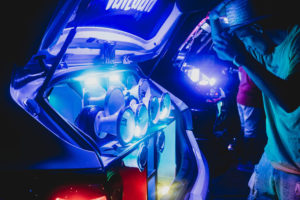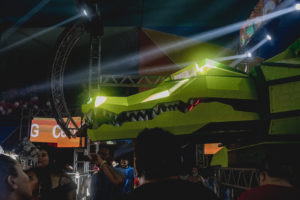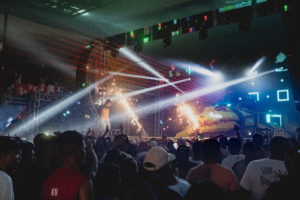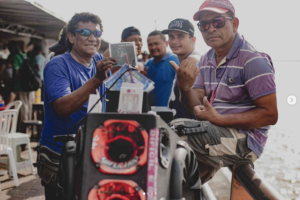The Music Technology of Urban Amazonia
We are particularly interested in the mobile apparatuses used to play recorded music. This specifically technological angle of the SST project cuts across the music genres and geographies that most often define research on popular culture. It enables us to explore how different technologies are being deployed for building communities and solidarities in different cultures and music scenes around the world. One of the most literally spectacular of SST are the aparelhagens of Belém in the Brazilian Amazonia, as this week’s blogger explores.
Text by Natalia Figueredo
Images by Bruna Brandão
I’ve been living far from my hometown, Belém, for a few years now. Every time I return home, I can feel the taste of nostalgia in my mouth when listening – from the tenth floor of my parents’ flat – to cars with sound systems that advertise parties around the city. A folk theory I known in Belém says that the levels of decibels are higher than the Brazilian average sound limit. And I can attest to it. A good example of this culture of loud music are the parties – aparelhagens – announced by these cars with powerful sound systems.

Picture taken at a party organized by owners of sound system-equipped cars with the aparelhagem Principe Negro in the city Ananindeua-Pará. They gathered to see some of the greatest exponents of the scene: DJ Lorran, DJ Méury, DJ Hud and Dj Mayara. Image © Bruna Brandão
The aparelhagens are a traditional cultural phenomenon in the city of Belém, located in the Brazilian Amazonia. This phenomenon also spreads throughout the state of Pará and its capital Belém. The aparelhagens are complex technological apparatuses composed of a large sound system and lighting structures, being the DJ the main attraction. However, as the researcher Lydia Barros (2015) points out, the key to the success of an aparelhagem is the technological innovations they present. That is, the quality of an aparelhagem is measured by its ability to offer the best experience in terms of light, sound and media spectacle (Bahia, 2015).
On the Christmas holidays of 2022, I will be back home once again. Even planning months prior, the parties scheduled are many. One of them is the biggest aparelhagem in Belém now, the Crocodilo. As the name suggests, the DJ’s booth – or nave (’ship’) as it is popularly known in Belém – is shaped like a crocodile. The structure is entirely covered with LEDs and during the party there is a fireworks show while the crocodile moves.

Figure 2- Picture of aparelhagem Crocodilo in 2017 at the club Karibe Show in Belém. Image © Bruna Brandão.
The Crocodilo was founded in the early 2000s. Initially, it was a small sound system that played at parties in Jurunas, a neighbourhood in Belém and it was considered a neighbourhood sound system. Virality had a massive effect on the popularity of the hit Faz a Boquinha do Animal which helped the project to reach unimaginable heights. The lyrics talk about the animal crocodile, making reference to the aparelhagem. The song invites people to dance by opening and closing their hands as if it were the crocodile’s mouth. The chorus says “make the animal’s mouth”. The music got viral in Brazil and the choreography was widely spread on TikTok.
This song was produced by the MC Dourado [2], a singer and songwriter, along with DJ Meuryi [3]. The success is also attributed to the fact it was recorded by Kondzilla studio, which is one of those responsible for the massive diffusion of the funk Carioca. Also, has nowadays the seventh largest music channel in the world on YouTube. The success of the music “faz a boquinha do animal” resulted in a greater interest in the aparelhagem parties. This renewed interest propitiated by the growing public allowed DJs and producers to invest in a larger structure.
The structure of an aparelhagem is usually made of wood, steel and formica, LED lights and TVs. It can vary in size – small, medium and large (Maia, 2012). According to João do som, one of the people who contributed to design and build sound systems in Belém, the size of an aparelhagem depends on the budget of the person or group investing in the structure [4]. In other words, aparelhagens in Belém are private companies that have sound, lighting and scenography to animate events.
In the case of Crocodilo, there was a process of gradual evolution of the technological structure, indicated by the constant transformation in its name. In other words, each time the technology got more modern, the name changed. It started out as “Incredible Crocodilo“, went on to “Giant Crocodilo” and the aparelhagem currently introduces itself as “Surreal Crocodile”, sometimes adding the word ‘prime’ at the end of its name – “Surreal Crocodile Prime”. The structure is currently made up of sound and light equipment to set up small events for 2,000 to 50,000 people.

Picture of aparelhagem Crocodilo in October of 2022. During this month, the parties are crowded due to an important celebration in Belém, the Círio. It is one of the largest Catholic processions in Latin America, which also moves the local culture and non-religious festivities in the city. The picture was taken at Palácio dos Bares, one of the most famous clubs in Belém. Image © Bruna Brandão.

As the previous one, this image shows aparelhagem Crocodilo at the same party in October of 2022 at Palácio dos Bares. Image © Bruna Brandão.
João do Som was the one who carried out the Crocodilo’s project. He told me in an interview that for major events he designed a structure that is composed of the entire body of the animal (crocodile). The Giant Crocodile is an eight meters structure from head to tail, covered in high resolution LED boards. For smaller parties with just a few DJs, a smaller structure composed only of the crocodile’s head is normally used. This is also covered in lights and able to set off fireworks. João pointed out that these structures are usually modular to adapt according to the shape of the venue and facilitate transport.
Junior Almeida, a DJ involved in the tecnobrega scene, told me that latterly the aparelhagens have gained gigantic proportions [5]. He explains that the clubs and places to organize parties in ’the capital’ – as he refers to Belém – did not follow the evolution of the sound systems in terms of size, making it difficult to assemble a complete structure during most events in Belém. For this reason, the teams that make up the aparelhagens have also started to invest in smaller structures.
The musician also explained that another common situation faced by the aparalhagens is that the people, especially those who don’t know the scene, associate the size of the sound system with noise pollution. Often, even before the party starts, there are complaints. In our conversation, he remembered a time when the truck with the sound system he was going to play was stopped by the police while still on his way to a party in another city.
This dynamic reinforces the role of the DJ at the aparelhagem. Junior explained that often the DJs plays without the structure that represents the aparelhagem – the nave. So, they add the aparelhagem’s name to the name of the DJ to identify their team as a way of promoting an aparelhagem party rather than a DJ party. In this smaller format, the DJ can play up to 4 or 5 times in a day, earning even more than if they have to bring the complete sound system. These aspects eventually changed the scene. As in the case of the Crocodilo, the aparelhagens started to organize parties in different formats, making an average of fifteen appearances per month.
The aparelhagem is a travelling event that also goes to smaller cities in the countryside. It is in this occasion that the complete structure is normally used. Keila [6], who has been a tecnobrega singer for over ten years now, explains that when the aparelhagem goes to the countryside it becomes a huge event. They bring an enormous structure, and the party starts earlier and ends later. Usually, caravans organized by fans of the difference aparelhagens of Belém travel to follow them. These large sound systems also respond to a need for cultural events in smaller cities.
These large structures are constantly changing over the time. Their owners, such as Cidinho from Crocodilo, present a strong discourse that extols the role of technological innovation for the sound system scene. In the Crocodilo’s presentation, for example, the team introduces itself with the phrase “who dares, triumphs”. As these sound systems are constantly looking for new technologies to present at parties, João do som explained that normally every two years the structure becomes obsolete, so a new one needs to be built.
Junior Almeida draws attention to the fact that people who attend these events not only like to have fun but also to witness the technological innovations. Which, to some extent, explains why Crocodilo is the booming sound system at the moment. Almeida explained that since its origins, the most modern technologies have been in the structure of aparelhagens. So, people who went to the parties could see something unprecedented. For Junior Almeida, the aparelhagem represents the future.
At parties organized by the Crocodilo and other aparelhagens, there is an organicity among the participants, the music and the environment. The DJs stimulate the audience’s reactions by talking to the crowd besides mixing the music and there’s also pyrotechnic effects, such as explosion of confetti and fireworks. In addition, DJs often mention names of people present at the parties. Almeida mentioned that everyone who’s there wants to hear its name announced. He said, “do you imagine a person who works all month to earn a minimum wage and then goes to the sound system and has its name announced as an important person? It makes us feel like we own the party, that we are part of the aparelhagem”.
The performance of the DJs is recorded during the event. Afterwards, a CD with this recording is made available at the end of the party. Many people buy this recordings including their names to keep them as memories or as presents to friends. The commercialization of these CDs explains a little about the origins of the aparelhagem. These parties were born from the popularization of the Tecnobrega rhythm in the late 1990s and early 2000s. Sound systems are thus part of the tecnobrega production circuit, as shown by Lemos e Castro (2008, p. 22):
Simplified, we can say that the tecnobrega market works according to the following cycle: 1) artists record in their own or third-party studios; 2) the best productions are taken to large-scale distributors and street vendors; 3) street vendors sell CDs at prices compatible with the local reality, also advertise them; 4) DJs play those productions at parties; 5) artists are hired for shows; 6) at concerts, CDs and DVDs are recorded and sold; 7) bands, music and aparelhagens are successful with these songs and feed the cycle [7]

Informal sale of CDs at the Ver-o-Peso Market, on the banks of the Guamá River in Belém. This Bike-sound passes as if they were small sound systems, selling pen-drives and CD’s. Image © Bruna Brandão.
The tecnobrega is part of Belém’s landscape, it is possible to hear this rhythm in every corner of the city. Since 2013, State Law 7.708/13 declares that this music genre, which is the essential rhythm of aparelhagens, is Pará’s cultural and artistic heritage (Marques Fernandes, 2020). Tecnobrega is a very danceable electronic music, with a synthetic beat made in the studio, where producers use computers, and software to mix samples and loops (Rodrigo Moreira Magalhães, 2017). Due to the geographical position of Belém, tecnobrega is also heavily influenced by Caribbean rhythms. For this reason, Lydia Barros describes tecnobrega as a “borderline sound” (2015, p. 136).

Picture of a couple dancing to the sound of the aparelhagem Tremendão Tupinambá. Image © Bruna Brandão.
Although sound systems play a fundamental role in the dissemination of tecnobrega, many aparelhagens play other different rhythms, especially the songs that are successful in Brazil and worldwide. This is the case of Crocodilo which has a vignette that says they are “the play-everything-animal in Pará” (o animal toca tudo do Pará). In this kind of party, the DJs keep the rhythm base and the same tempos of tecnobrega to go from one song to another, acting mainly in the mixes. This style is what the public calls “pressure” (pressão). One of Crocodilo’s main DJs, for example, is called Dinho Pressão.
Keila explained that in other parts of Brazil, Tecnobrega never managed to go mainstream and stop being considered as an alternative music style. That is, outside Pará Tecnobrega is only listened to by those people who like other styles of contemporary Brazilian music besides the more popular ones such as samba or funk carioca. She recounts that even after ten years in the business, she can’t escape having to explain the meaning and history of is tecnobrega to researchers and journalists from other regions of the country.
On the other hand, Keila said this is a good moment for this rhythm. She explains that with the rise of funk carioca other peripheral cultural movements have been valued. She points out that one rhythm has been pulling the other. Despite the vast majority of times people describes tecnobrega and aparelhagem as a cultural phenomenon that happens – only – in the periphery, this cultural phenomenon is all over Brazil.
A great example is that this year Keila along with Crocodilo’s DJs performed at one of the biggest musical festivals in Brazil, called Rock in Rio. Another positive aspect is that the structure for the performance was built by João do som. In addition, the Crocodilo’s nave was used by a Brazilian singer Anitta in one of her music video productions. Even if she did not sing a tecnobrega song, nor made her music with a local DJ, the use of Crocodilo’s structure shows the success and power of the sound systems from Pará.
The cycle developed by the production chain around the aparelhagem is an important reference for the production of cultural goods. Not to mention the autonomy in relation to the phonographic industry. This cultural movement allows the formation of more inclusive cultural markets, by providing emerging technologies to peripheral to create their own mechanisms of production, distribution and cultural circulation.
For this project I organized a playlist for you to listen to the sound of Pará: Playlist Festa de Aparelhagem on Spotify.
—
Natalia Figueredo is an Architect and Urbanist (Escola da Cidade – São Paulo), and cultural theorist (Goldsmiths University of London) from Belém in the Brazilian Amazonia. She is currently doing a PhD in culture and society in Barcelona.
Bruna Brandão is a social communicator (Federal University of Minas Gerais) and photographer (Cambridge School of Art). She is currently a photographer for the Minas Gerais Philharmonic Orchestra and a member of the Flanares photo collective.
References:
[1] I call this a ‘folk theory’ as I could not confirm it.
[2] MC Dourado is a singer from São Paulo – southeast of Brazil – living in Belém.
[3] Dj Meury is recognized in Pará as the first female DJ to produce hits in the Tecnobrega scene.
[4] Vice magazine published an article about João do Som (Pinheiro & Agência PLANO, 2017), who nowadays is one of the most important people in the development and execution of sound system projects in Belém.
[5] Junior Almeida (@sonoroparaense ), besides being a DJ, is involved in the production of a documentary with aNorth American researcher Darien about the origin of aparelhagens (2022). That’s because his father Milton Nascimento (not the famous Brazilian musician) was one of the people who started the construction of these sound systems in Pará, better known as sonoros paraeneses.
[6] You can find more about Keila on her Instagram @tremekeila and listen to her music on Spotify.
[7] Translated by Natalia Figueredo. See also the documentary Brega SA (2008) on the tecnobrega scene in Belém, available on YouTube at this link.
Bibliography:
Bahia, M. (2015). The Periphery Rises: Technology and Cultural Legitimization in Belém’s Tecnobrega. Journal of Lusophone Studies, 13. https://doi.org/10.21471/jls.v13i0.3
Barros, L. (2015). A validação do Tecnobrega no Contexto dos Novos Processos de Circulação Cultural. Novos Olhares : Revista de Estudos Sobre Práticas de Recepção a Produtos Mediáticos, 4(1), 135. https://doi.org/10.11606/issn.2238-7714.no.2015.102230
Lamen, D. (2022). HOJE ESTAMOS AQUI – official trailer (English subtitles) – YouTube. https://www.youtube.com/watch?v=hHsK-Xeyapk
Lemos, R., Castro, O., Favareto, A. da S., Magalhães, R., Abramovay, R., Tosta, A., Ignácio, E., Simas, M., & Menezes, M. (2008). Tecnobrega: o Pará reinventando o negócio da música. Aeroplano Editora. http://hdl.handle.net/10438/2653
Maia, F. (2012). As Novas Aparelhagens Sônicas Que Fazem Belém Vibrar. MOTHERBOARD Tech by Vice . https://www.vice.com/pt/article/4xnz8d/as-aparelhagens-sonicas-que-fazem-belem-vibrar
Marques Fernandes, M. B. (2020). O Pará que «Treme»: Compreendendo o Tecnobrega como Património Cultural Imaterial. CEM (Porto, Portugal ), 11.
Pinheiro, R., & Agência PLANO. (2017). Conheça João do Som, o arquiteto de aparelhagens do Pará – VICE. Vice Brasil. https://www.vice.com/amp/pt/article/ywbxby/joao-do-som-aparelhagens-para
Rodrigo Moreira Magalhães. (2017). Experiências do lugar: uma etnografia de festas de aparelhagem nas periferias de Belém do Pará, focada em seus frequentadores. Universidade Federal de Minas Gerais (UFMG).
